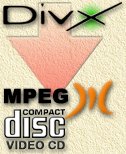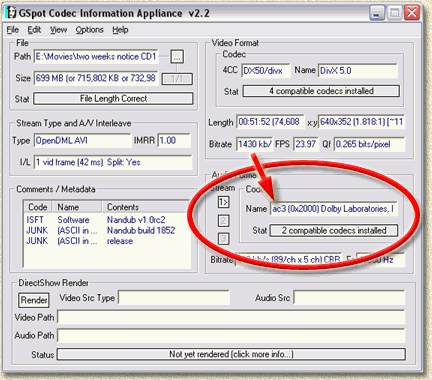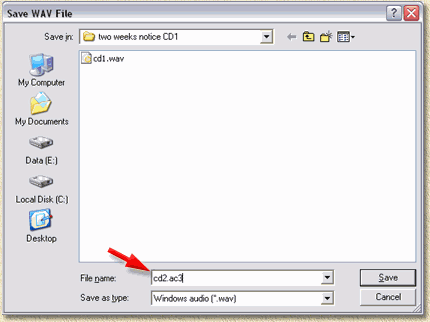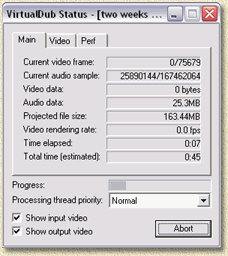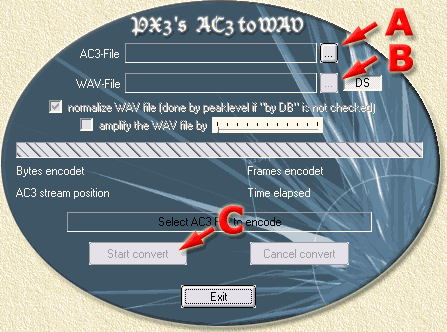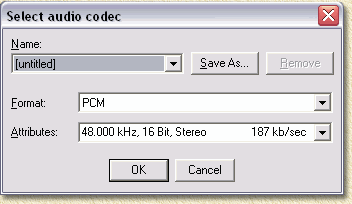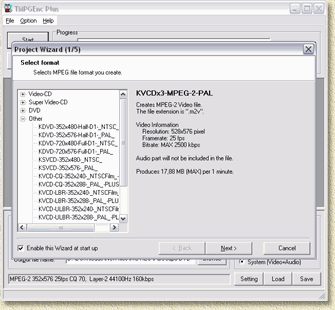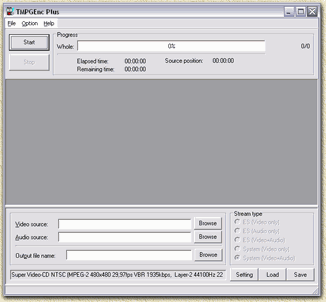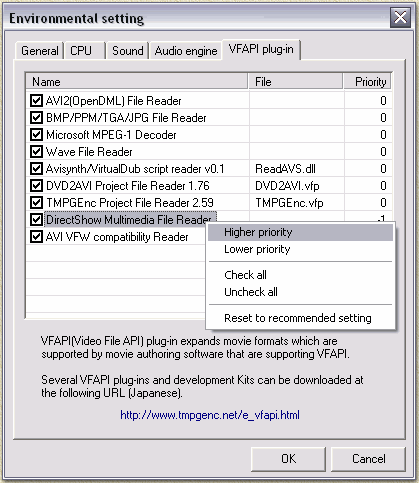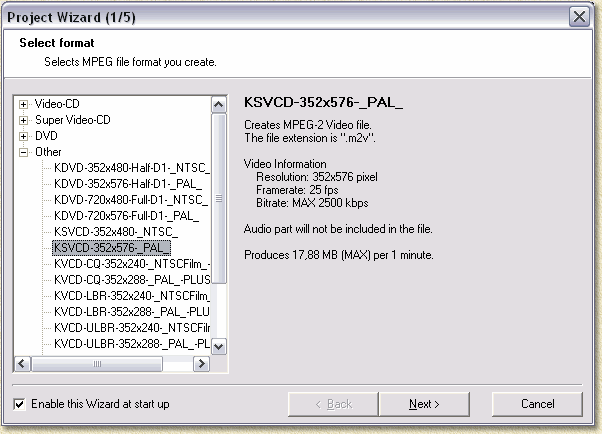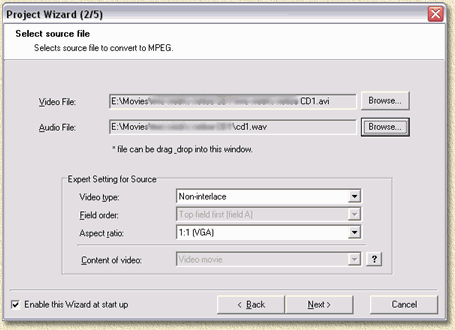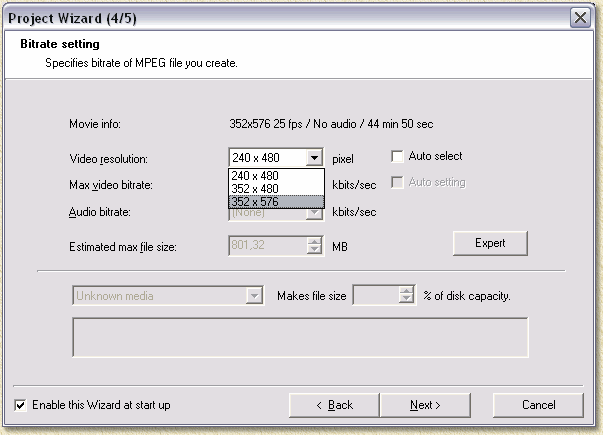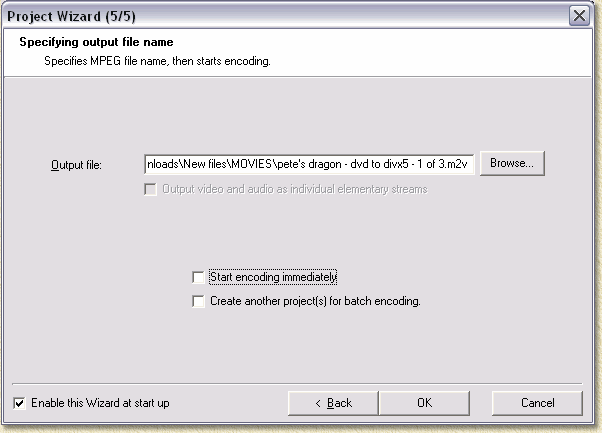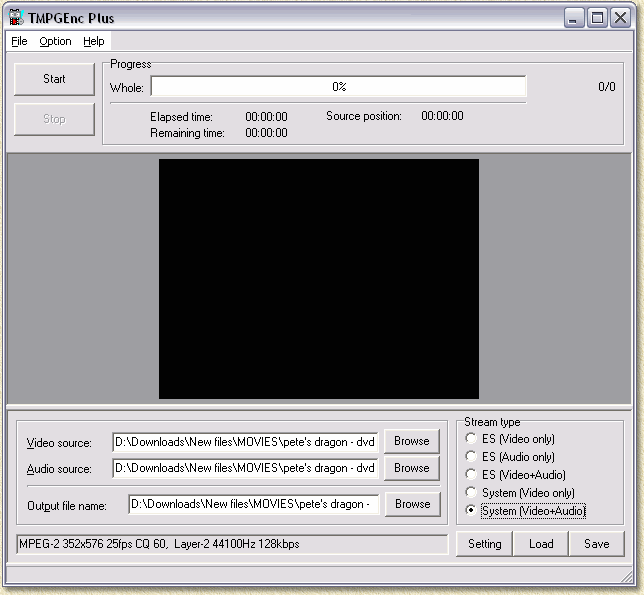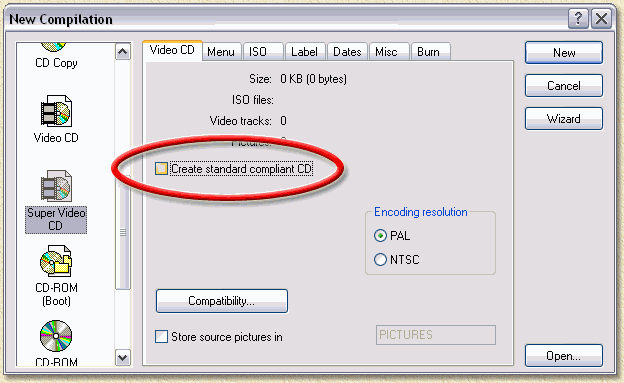
| Print this page - use Landscape |
Search the WeetHet Pages |
|||
| WeetHet is being updated! - Current articles will slowly move to www.tweaking4all.com For excellent webhosting that is reliable and affordable, we highly recommend: LiquidWeb |
||||
|
On this page ...
The required software Software for movie playback First try if you can playback the movie on your PC using the Window Media player. If not, then we will need to install (if not already) the Video Codec. For DivX go to the DivX homepage . This is needed for playback. TMPGEnc uses the codec suitable for the movie, just as it does with basically any AVI file format. In order to transcode to KVCD, KSVCD or KDVD, we will need to install the KVCD templates. See the K(S)VCD Intro page for details. Software for dealing with the AC3 audio We will deal with the AC3 separately, and need these tools to work with it: VirtualDub, which we use to extract a copy of the AC3 audio to a file. VirtualDub can be downloaded from the VirtualDub homepage. PX3's AC3 to WAV can be found at the WeetHet download page. We need this tool, to convert AC3 to a regular stereo WAV file. Installation is easy: extract the RAR file in a folder and start the program by double clicking the PX3Convert.exe. Software for subtitles For this purpose I recommend using FFDShow
(although VobSub will do just fine too). Software for transcoding Here we are at the core of our conversion process (called "transcoding"). Download TMPGEnc from the TMPGEnc website. First use the trial version to see if it works the way you expect it before buying the "Pro" version. I know I'm convinced that this is a tool worth it's money, but make sure you do too. Install it and run the application. Software for determination of the required codec's It is not a must, but might save you some headaches: we use GSpot to verify that the AVI indeed has an AC3 audio track. Either get it from the WeetHet download page or from the GSpot website. Install the software first! Step 1: Verify that it is indeed AC3 First we should verify if the AVI indeed has an AC3 audio track. We will use GSpot for that purpose (download it from the Download Page). Start GSpot (find more details on the GSpot page) and open the AVI in GSpot. GSpot will no analyze the AVI:
In this example we have an AC3 audio track! Check out the field "Name" in the "Audio Format" - "Codec" section. You'll see the text"ac3 (0x2000) Dolby Laboratories, Inc". If this is the case: continue reading :-). Either close GSpot or analyze the next AVI file. StEp 2: Extracting the AC3 audio In this step we will extract the AC3 audio to a separate file. We'll use VirtualDub for that - although other applications out there can do this as well. Start VirtualdDub and open the AVI file using the menu "File" - "Open Video File" (or press the keys CTRL+O). Use "File" - "Save WAV ..." to save the audio separately. A file dialog will show, enter the desired filename, using the ".AC3" extension. For example "mymoviesound.ac3".
VirtualDub will now show you the progress while saving the AC3 audio:
This won't take long, only a few minutes tops (depends on your PC though). Once this dialog disappears, VirtualDub is done making the file. Either close VirtualDub or get the next AVI file. Step 3: Converting AC3 to WAV We're going to use PX3's AC3 to WAV to convert AC3 to a normal stereo WAV file. Start PX3's AC3 to WAV (download it from the download page).
This is a very easy to use tool .... First click the button indicated by the arrow A. A file dialog will ask you which AC3 file to use. Select the file you just created with VirtualDub. Next click the button indicated by the arrow B. Again, a file dialog will appear asking you to enter the name of the WAV file it should generate. For example "mymoviesound.wav". Now click the "Start convert" button (indicated by the arrow C). Now a window opens asking you which format to use:
Please choose PCM (48.00 kHz, 16 bit stereo - as seen in the picture above). Finally click "OK" and PX3's AC3 to WAV will now start converting the AC3 file to a WAV file. This won't take long either. Once the PX3's AC3 to WAV tool is done, you can either close it (press the "Exit" button) or convert the next AC3 file.
Step 4: Preparing TransCoding Transcoding means something like "converting from one format to another". After downloading and installing TMPGEnc, start it. You will see a window like this (I used version 2.59.47.155 Plus):
As you can see, TMPGEnc can start with or without wizard. After a fresh install, TMPGEnc usually starts with the wizard. We will continue working with the wizard. Tip: In case the wizard is not visible, choose from the "File" menu the option "Project Wizard" (or simply press the key combination CTRL+W). Before we can use subtitles, we need to do some settings in TMPGEnc. For that purpose we need to leave the Wizard for a minute. So if you're in the Wizard right now, click the "Cancel" button. From the menu "Options" choose "Environmental settings". In the upcoming window, choose the tab "VFAPI plug in". We will now increase the priority of the DirectShow filters so they will be used during transcoding. This is done by giving "DirectShow multimedia file reader" top priority. Right click "DirectShow Multimedia File reader" and click the option "Higher priority". Repeat this until "DirectShow Multimedia File reader" is on the top of the list.
Click "OK". Note: while working with TMPGEnc, using an AVI that has subtitles, you will notice a green arrow appearing in the systray (where the Windows clock can be found - lower right corner of your screen), which indicates VobSub activity:
FFDShow can also be seen in the Systray (if set in the FFDShow preferences):
Note: ONLY WHEN USING VOBSUB: if the arrow DOES not appear, then verify if both AVI and subtitles have the same filename, for example MYMOVIE.AVI and MYMOVIE.SUB Step 5: Select the proper format
OK, in this wizard screen we can choose our target format. Make sure you do select the proper one. Try to avoid transcoding NTSC to PAL and vice versa as this usually causes problems with playback! Most DVD players support KVCD and KSVCD (See DVD Compatibility Database). Now click the "NEXT >" button. Step 6: Select Source file(s)
At the Video field click the "Browse..." button, and choose the AVI you want to convert. Close the dialog (after selection) by clicking "OK". At the Audio field click the "Browse..." button, and choose the WAV file we created with PX3's AC3 to WAV tool. Close the dialog (after selection) by clicking "OK". Note: Do NOT copy the other settings, like "Video type", "Field order", TMPGEnc will automatically enter data into these fields! Click "Next >" again. Step 7: Filter settings Leave this page as it is and click "Next >" again. Note: none of the checkboxes (except "Enable this Wizard at start up") are checked! This step is a bit more complicated, so please pay attention here! Make sure you select the proper resolution as recommended in the K(S)VCD Intro table!
Click "Next >". Step 9: Output File In the next window, we select the "Output file:", the filename of the transcoded movie. Either enter it manually or click "Browse...".
NOTE! Remove the checkmark at "Start encoding immediately". Finally click "OK". Step 10: Ready to go? The next screen:
Make sure you check "System (Video+Audio)" !!!!!! Final Step: Start transcoding This is simple: Click the "Start" button and wait hours ... (Usually 1 hour of video takes between 1 and 2 hours transcoding - depending on your PC!). As soon as TMPGEnc starts transcoding, you will see again the green VobSub arrow in the SysTray:
FFDShow can optionally be seen in the Systray as well. This depends on the FFDShow settings!
Note: For VOBSUB ONLY: if the arrow DOES not appear, then verify if both AVI and subtitles have the same filename, for example MYMOVIE.AVI and MYMOVIE.SUB. Burning a K(S)VCD After the transcoding process you can use Nero (or similar (S)VCD capable application) to burn the CD. Note: you might want to check the result, as sometimes audio and video tend to run out of sync! Note: Nero Express will not work properly as it will try to transcode the MPEG video again!!! Try to switch to the normal Nero interface!
|
||||

